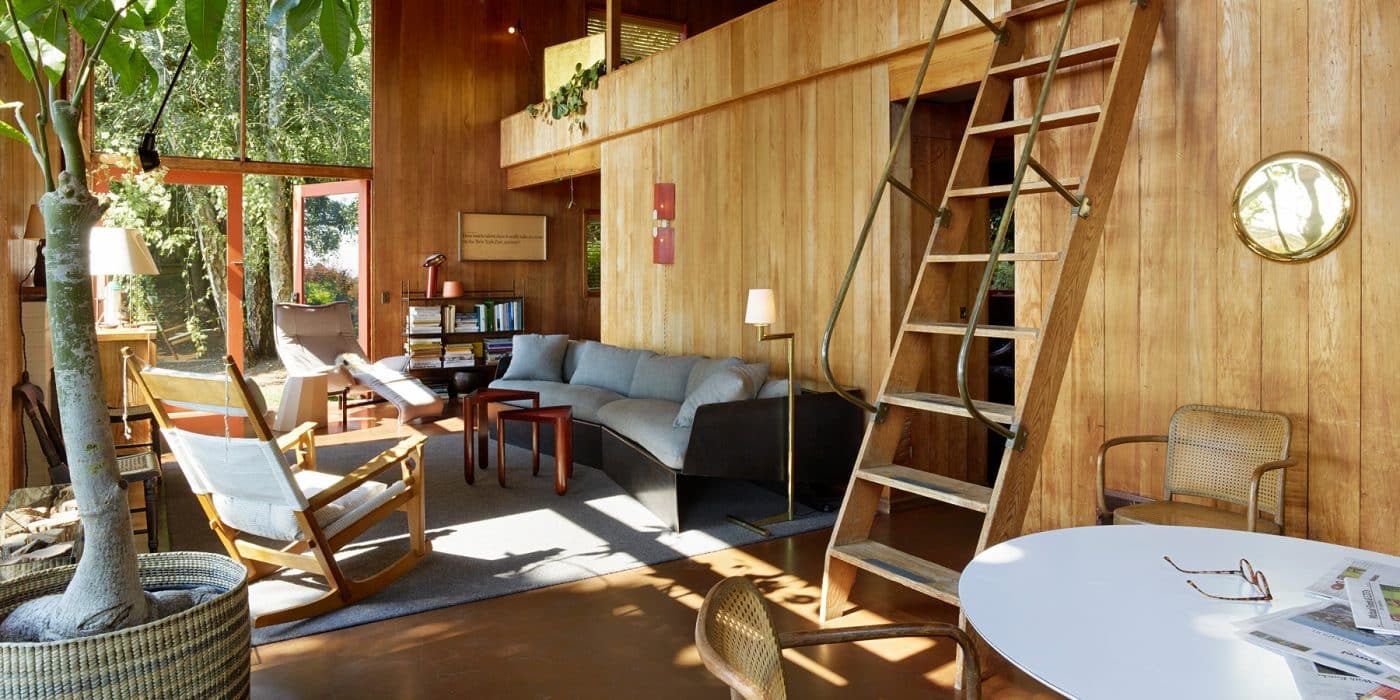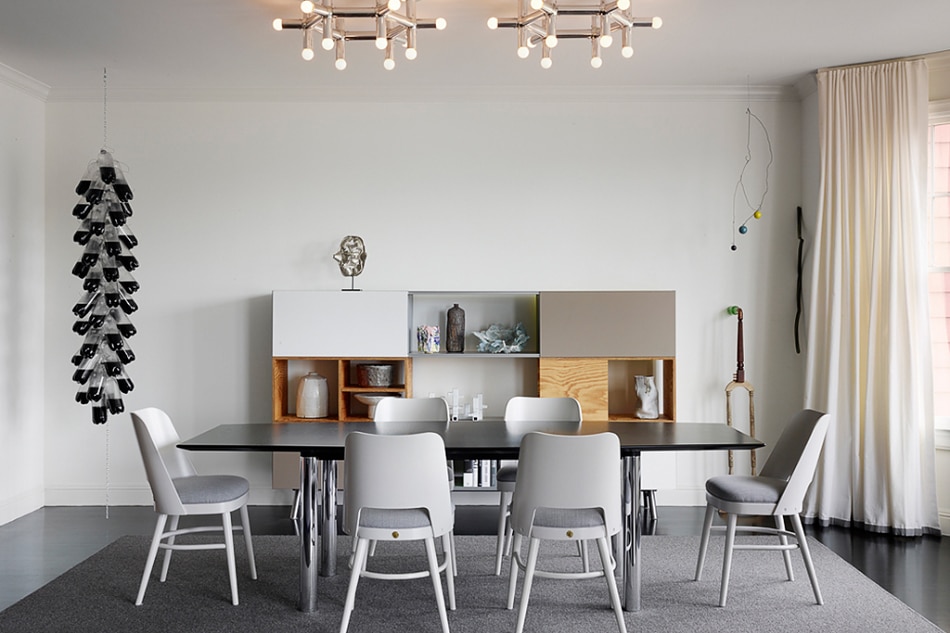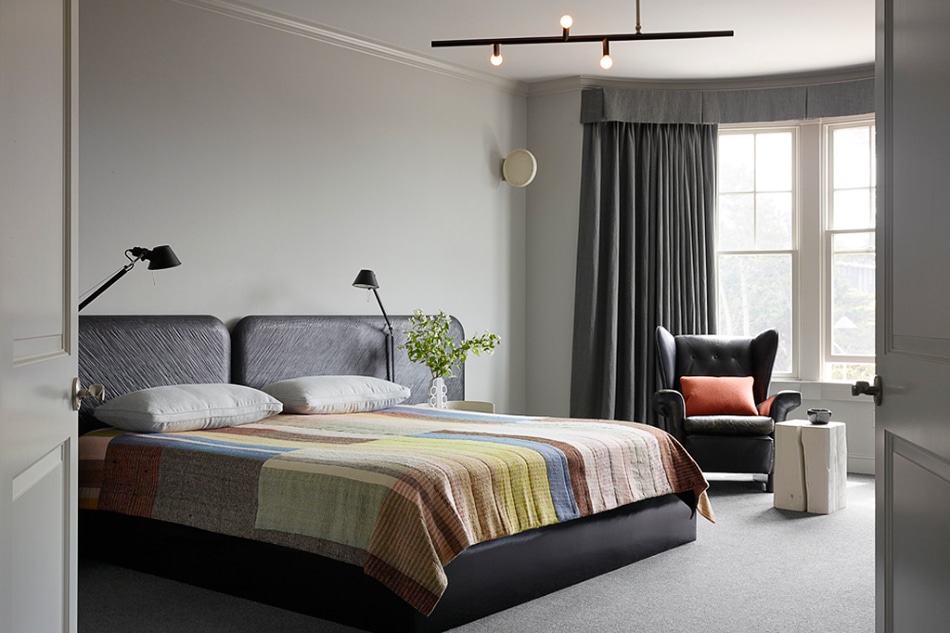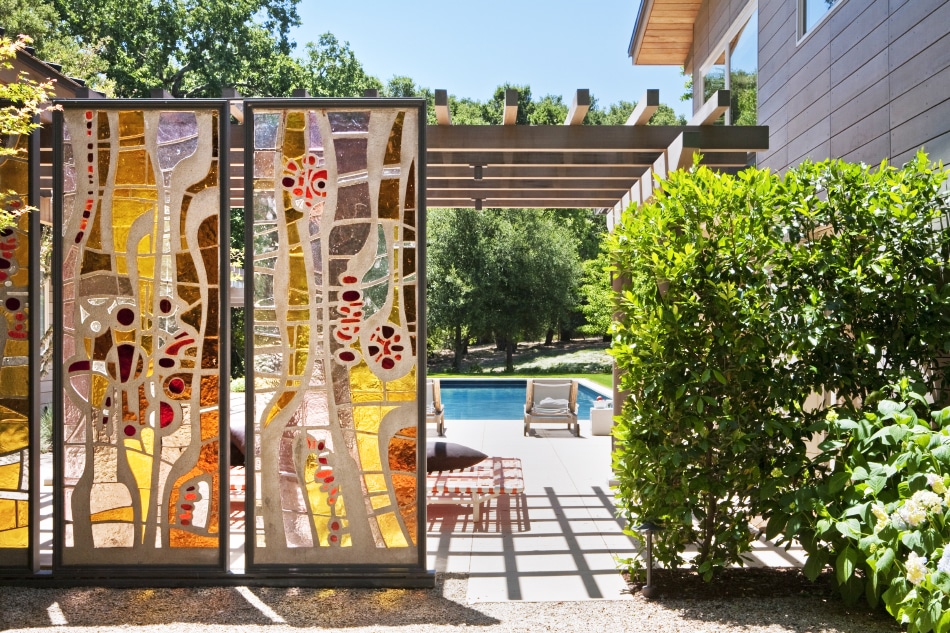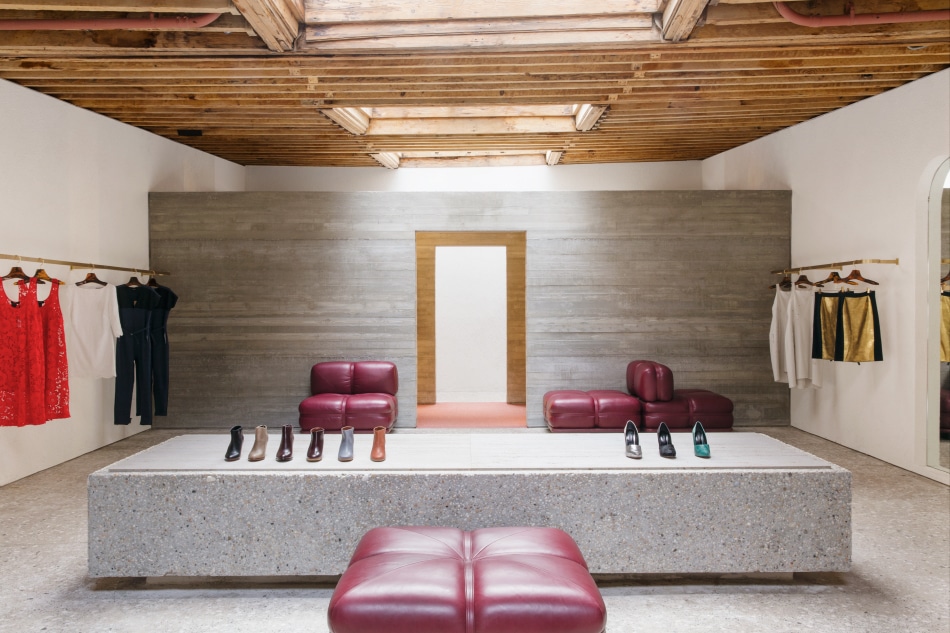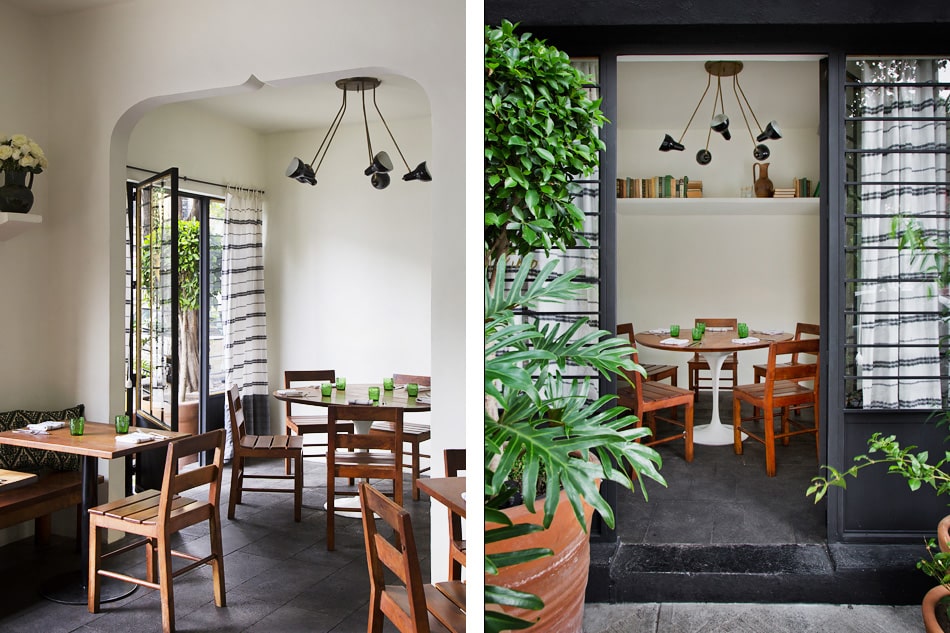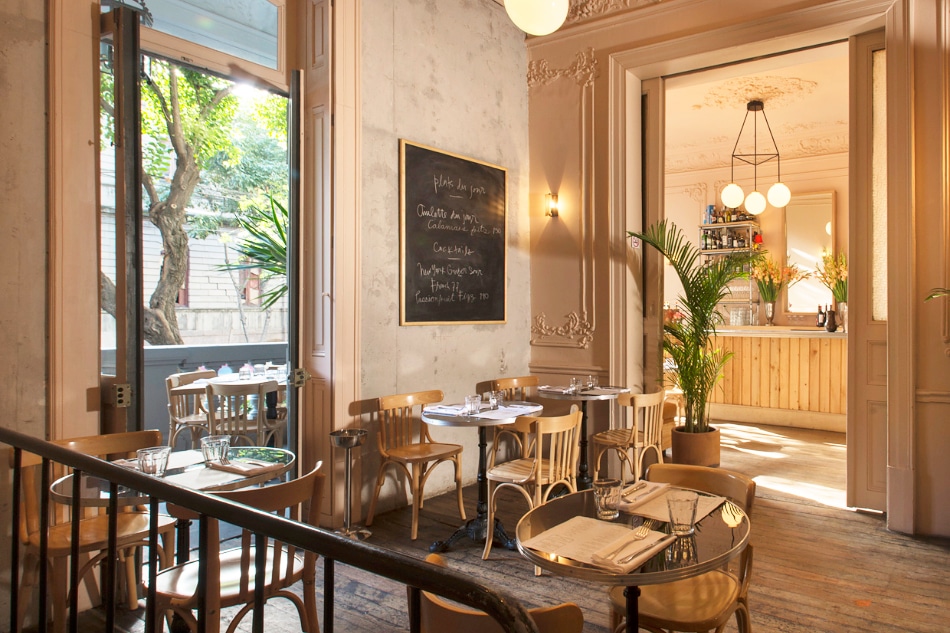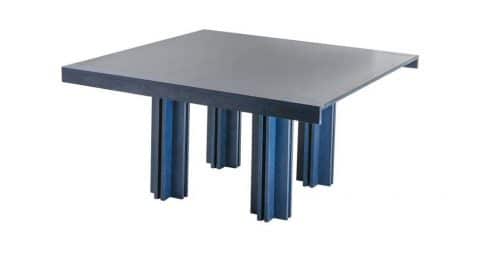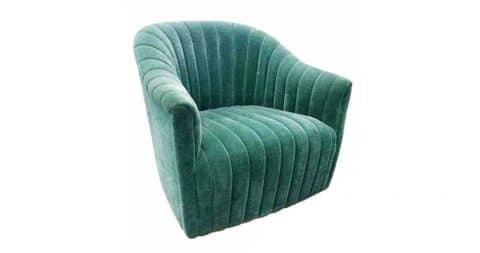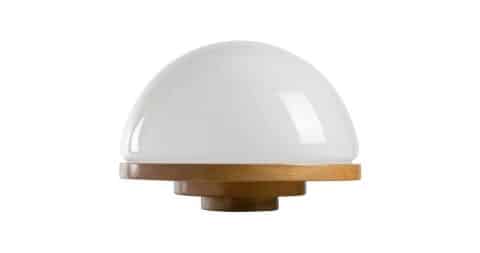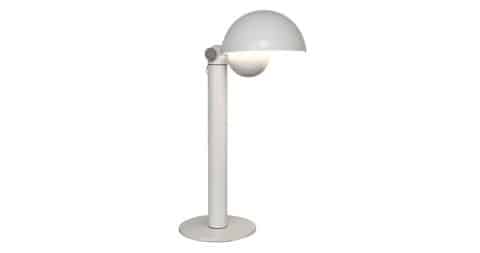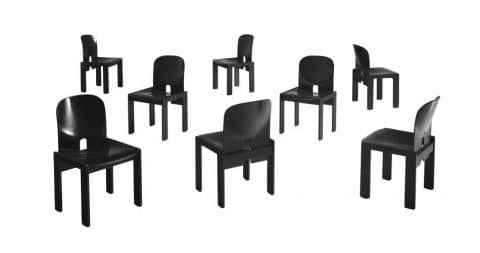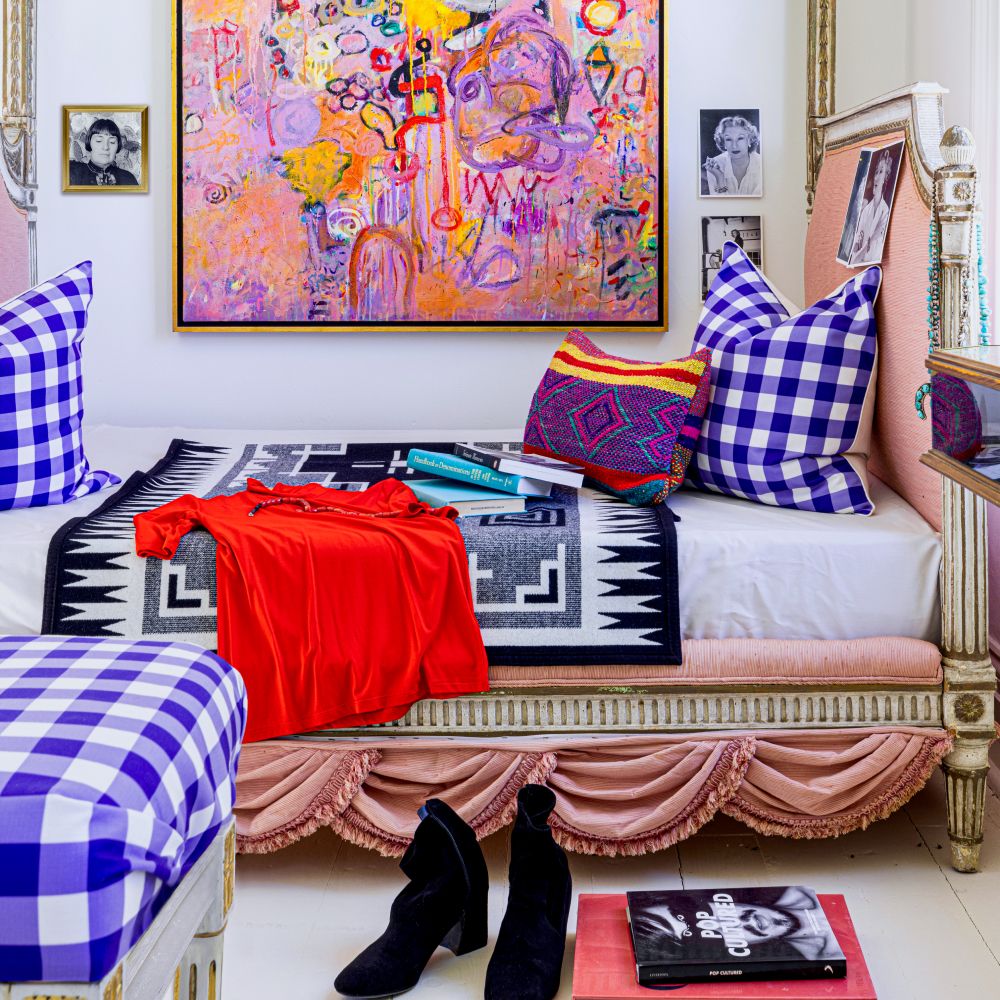
January 15, 2018Charles de Lisle, who lives in Mill Valley, north of San Francisco, describes himself as “a problem solver” (portrait by Daniel Dent). Top: In the living-dining area of his home — originally designed by Donn Emmons in 1948 — de Lisle combined his own Steel sofa and Scout cocktail tables with a Hans Wegner Keyhole rocking chair, an Eero Saarinen table and a bentwood Josef Hoffmann armchair (photo by Matthew Millman).
Charles de Lisle has no signature style, and he doesn’t much care for rooms with a lot of furniture or fuss, so you might call him an un-designer. Yet he is a great believer in spaces that he calls “events.” He had his come-to-Lady-Mendl moment back in 1995 when he was a young man working as a welder for an event designer and visited a house in the San Francisco hills designed by Michael Taylor. Taylor was the legendary creator of the “California look” in decorating, characterized by oversize furniture, neutral color schemes and high-drama organic elements. De Lisle had never seen, much less “experienced,” such an environment and instantly became a convert to the immersive power of great decorating.
If de Lisle has no signature style, this sly, Mill Valley, California–based talent, born and raised in the rural hinterlands of Massachusetts, does have a tell: His remarkable rooms employ a distinct but limited array of tones, textures and forms, with crisp details throughout. But don’t call him a minimalist, as there is nothing austere or doctrinaire about his spaces. They are as inviting as they are intriguing — and they’re highly personal. “There’s always some oddball thing I find for a room,” he notes with a chuckle. It might be the surprise of pleated black-and-white-gingham-cotton walls for the living room of a decorator showhouse furnished with a pair of glam acid-yellow ’70s-style upholstered armchairs that he designed, or the transformation of a bank vault into a conference room outfitted with crystal chandeliers and Jens Risom chairs for a San Francisco real estate company, or the whimsical inclusion of a pair of Pelican chairs by Finn Juhl in an otherwise spare master bedroom of a house in the Bay Area’s Marin County. “I like to challenge my clients,” he says — although, in truth, de Lisle doesn’t seem like a fellow inclined to test anyone, but rather someone who likes to delight people with ideas that are ahead of the curve.

Throughout the Portola Valley home, de Lisle used cedar ceilings and built-in cabinets to complement clean, white adobe walls. Another of his Linden chandeliers hangs over a custom laminate and plywood table of his own design, while vintage T.H. Robsjohn-Gibbings dining chairs for Widdicomb sit at the table. Photo by Matthew Millman
While self-trained, de Lisle has the necessary swagger to take on any look. “I’m a problem solver,” he says. That’s why he’s attracted to projects that put him slightly off-kilter, like a current one in New York where the client has asked him to outfit her apartment with the traditional furnishings she inherited from her family. Rather than be put off by such retro fodder, de Lisle admits to adoring the challenge of deploying chintz, ruffles and fringe in fresh ways custom-tailored to her.
If de Lisle has an unusual gift for assembling highly original room-scapes, it may be because he didn’t set out to be an interior designer. He began his career as a tinkerer and maker. He prides himself on having inherited the self-sufficient Yankee Mister Fix-It skills of his father, a manufacturer of colonial reproductions, and of his grandfather, a machinist. Which explains why his aesthetic take is so different from those trained in the design trade. He did go to art school, but with the ambition of becoming a graphic designer. After being enlisted to build the school’s kilns, he discovered clay. (The accidents and detours that have shaped de Lisle’s career are as dizzying as they are fascinating.) What he calls “the cultural resonance of clay,” combined with its “functionality,” so captivated him that he changed his major to ceramics.
After graduating from college, de Lisle moved to San Francisco and set up a studio in Oakland, near the California College of Art, where he eventually took several courses in welding. He found metalworking as seductive as throwing pots. The complexity of the process — determining the proper jig to hold the material is as critical as the actual forging — engaged both the engineer and artist in him. He started experimenting with making various kinds of furnishings and lighting fixtures and took odd jobs welding display racks and the like for acquaintances opening retail shops. Through this work, he landed the fateful gig with the event planner. Once introduced to the heady world of the decorative arts, there was no turning back for de Lisle.
If de Lisle has an unusual gift for assembling highly original room-scapes, it may be because he didn’t set out to be an interior designer. He began his career as a tinkerer and maker.

In the California Street home, de Lisle arranged a collage of artworks and a pair of Artemide Tolomeo sconces over an A. Rudin sofa. To the left is an Eero Saarinen armchair. Photo by Matthew Millman
With his talents as a ceramist and a welder, he knew he had a strong understanding of three-dimensional space and could readily tackle the design of rooms. But despite a stack of sketches for various furnishings — which so wowed an executive at Knoll that she personally made calls to top San Francisco designers on his behalf — no one in the decorating business was convinced de Lisle could make the leap into interior design. Undeterred, he focused on playing with schemes for lamps. He found these especially absorbing, because they required a consideration of form and light combined with electrical engineering.
Going where he felt his talents most engaged, de Lisle illumined his own path forward. By 1997, he’d devised a table lamp — assembled out of powder-coated steel, with a silk and paper shade — that he considered simple but singular and eminently salable. He plotted out how to make the piece in large batches and created a distinctive box and label for it, drawing on his early graphics training. Then he took his design, which he called the Escondido, straight to New York, to the Soho store Troy, a reigning tastemaker. “As luck would have it, the proprietor, Troy Halterman, was manning the shop that day, and he promptly ordered twenty,” de Lisle recalls, still sounding half amazed a decade later. Within a year, he had so many orders to fill for stores in New York, Los Angeles and San Francisco that he had to farm out the production.
The following year, back in New York for the ICFF contemporary design show, he ran into a San Francisco acquaintance, who introduced him to an interior designer friend, Jonathan Staub. So impressed was Staub by de Lisle’s abilities that he bought 40 of the lamps for a hotel project, then invited de Lisle to work for the design firm he was founding with his cousin Marion Philpotts. Within three months, de Lisle was managing commercial, hospitality and residential projects for the company, and not long after that its name was changed to De Lisle, Philpotts & Staub.
The three worked together for about 10 years before de Lisle decided to go out on his own. His timing seemed terrible. It was 2009, and the world was in the midst of financial meltdown. But rather than panic, he took a vacation in Jalapa, Mexico. At the little resort where he was staying, he ate “the best piece of fish in my life,” he says, and sought out the chef, Eduardo García. De Lisle befriended García and his girlfriend, Gabriela López-Cruz, who he learned were planning to open an eatery in Mexico City. Six months later, the pair contacted de Lisle about helping them design and construct their restaurant space, located in what was once a wheelchair rental shop.

To create the candlelit plaster-bas-relief Tree of Life at Máximo Bistrot, de Lisle collaborated with a young artist whose artisan grandfather repaired the reliefs in the churches in the restaurant’s Colonia Roma neighborhood. Photo by Victor Benitez
The hitch was that the couple had only a minuscule budget. For de Lisle, that was simply an opportunity for some creative problem solving. He decided to have local people make everything. The restaurant’s inventive handcrafted design would communicate the delicious simplicity of the local and seasonal fare and so also serve as its branding. A huge mesquite tree in the field of a local farmer supplied the wood he used to fashion what he calls the restaurant’s “Luis Barragán–style” benches and rustic tables; a couple in Oaxaca wove the linens; and a multigenerational ceramics shop in town produced the dishes. De Lisle also enlisted a young artist whose grandfather repaired the neighborhood’s church reliefs. The two partnered on the restaurant’s focal point: a mythologically inspired Tree of Life. Weeks after it opened, Máximo Bistrot was already one of the most-talked-about restaurants in the city. De Lisle has gone on to design two other restaurants for the couple, Lalo! and Havre 77, with much bigger budgets.
Not surprisingly, more restaurants, shops, hotels and residential projects have followed. De Lisle also now has two lines of lighting fixtures, one more traditional, produced by Phoenix Day, the other more cutting-edge, sold exclusively through the Future Perfect.
True to his un-designer perspective, de Lisle doesn’t think of himself as an interior designer, even though he’s been a member of the trade for nearly 20 years. Instead, he likens his role to that of a film producer: “wrangling all those parts together — the client, the vendor, the maker — and figuring out how it can all work without a lot of ego, but enough to achieve a vision, a work of art.”
Charles de Lisle’s Quick Picks on 1stdibs
